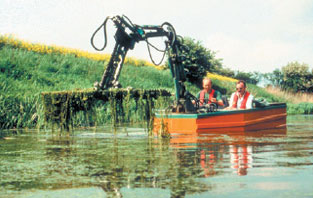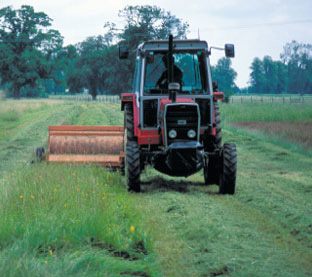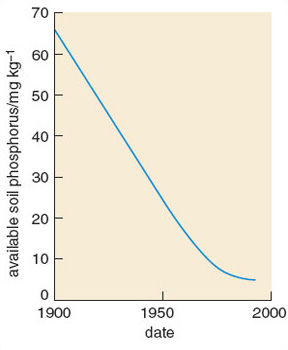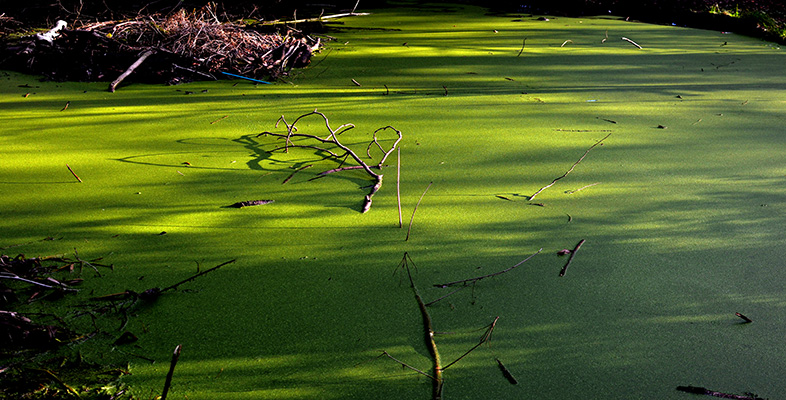4.4 Reducing nutrient availability
Once nutrients are in an ecosystem, it is usually much harder and more expensive to remove them than tackle the eutrophication at source. The main methods available are:
precipitation (e.g. treatment with a solution of aluminium or ferrous salt to precipitate phosphates);
removal of nutrient-enriched sediments, for example by mud pumping; and
removal of biomass (e.g. harvesting of common reed) and using it for thatching or fuel.
In severe cases of eutrophication, efforts have been made to remove nutrient-enriched sediments from lakes. Lake Trummen in Sweden accumulated thick black sulfurous mud after years of receiving sewage effluent. Even when external loadings of phosphorus were reduced to 3 kg P yr−1, there was still an internal load (i.e. that derived from the lake’s own sediment) of 177 kg P yr−1! Drastic action was needed. Eventually nutrient-rich sediment was sucked from the lake and used as fertilizer. The water that was extracted with the sediment was treated with aluminium salts and run back into the lake. This action reduced phosphorus concentrations and improved the clarity and oxygenation of the water. However, removal or sealing of sediments is an expensive measure, and is only a sensible option in severely polluted systems, such as the Norfolk Broads, England.
Removal of fish can allow species of primary consumers, such as the water-flea, Daphnia, to recover and control algae. Once water quality has improved, fish can be re-introduced.
Mechanical removal of plants from aquatic systems is a common method for mitigating the effects of eutrophication (Figure 4.7). Efforts may be focused on removal of existing aquatic ‘weeds’ such as water hyacinth that tend to colonize eutrophic water. Each tonne of wet biomass harvested removes approximately 3 kg N and 0.2 kg P from the system.

Alternatively plants may be introduced deliberately to ‘mop up’ excess nutrients. Although water hyacinth can be used in water treatment, the water that results from treatment solely with floating macrophytes tends to have low dissolved oxygen. Addition of submerged macrophytes, together with floating or emergent macrophytes, usually gives better results. Submerged plants are not always as efficient as floating ones at assimilating nitrogen and phosphorus due to their slower growth, resulting from poor light transmission through water (particularly if it is turbid) and slow rates of CO2 diffusion down through the water column. However, many submerged macrophytes have a high capacity to elevate pH and dissolved oxygen, and this improves conditions for other mechanisms of nutrient removal. At higher pH, for example, soluble phosphates can precipitate with calcium, forming insoluble calcium phosphates, so removing soluble phosphates from water. Various species have been used in this way. One submersed macrophyte, Elodea densa, has been shown to remove nitrogen and phosphorus from nutrient-enriched water, its efficiency varying according to loading rate. Nitrogen removal rates reached 400 mg N m−2 per day during summer, while for phosphorus over 200 mg P m−2 per day were removed.
In terrestrial habitats, removal of standing biomass is an important tool in nature conservation. Reduction in the nutrient status of soils is often a prerequisite for re-establishment of semi-natural vegetation, and the removal of harvested vegetation helps to reduce the levels of nutrients returned to the soil (Figure 4.8). However, if the aim is to lower the nutrient status of a nutrient-enriched soil, this can be a very long-term process (Figure 4.9).


Question 4.1
A short reach of the River Great Ouse in Bedfordshire was found to contain the following species:
| Common name | Scientific name |
|---|---|
| filamentous alga | Cladophora spp. |
| moss | Amblystegium riparium |
| fool’s water-cress | Apium nodiflorum |
| hornwort | Ceratophyllum demersum |
| mare’s-tail | Hippuris vulgaris |
| spikedwater-milfoil | Myriophyllum spicatum |
| yellow water-lily | Nuphar lutea |
| great water dock | Rumex hydrolapatham |
| water speedwell | Veronica anagallis-aquatica |
| sweet flag | Acorus calamus |
| water plantain | Alisma plantago-aquatica |
| lesser pond sedge | Carex acutiformis |
| reed sweet-grass | Glyceria maxima |
| yellow flag iris | Iris pseudacorus |
| greater duckweed | Lemna gibba |
| broadleaved pondweed | Potamogeton natans |
| bulrush | Schoenoplectus lacustris |
A similar length of the River Eden in Cumbria was found to have the following species:
| Common name | Scientific name |
|---|---|
| liverwort | Pellia epiphylla |
| moss | Calliergon cuspidatum |
| river moss | Fontanalis antipyretica |
| water horsetail | Equisetum fluviatile |
| white water-lily | Nymphaea alba |
| lesser spearwort | Ranunculus flammula |
| pinkwater speedwell | Veronica catenata |
| sedge | Carex acuta |
| bottle sedge | Carex rostrata |
| common spike-rush | Eleocharis palustris |
| broadleaved pondweed | Potamogeton natans |
Using the trophic rank scores in Table 4.1, calculate the mean trophic rank (MTR) for each stretch of river, and comment on whether the watercourse is nutrient-enriched (eutrophic). Assume all the species recorded are of similar abundance and therefore there is no need to weight scores according to relative abundance, as you would do in a real situation.
Answer
The River Great Ouse has a MTR of 3, suggesting it is enriched with nutrients and therefore eutrophic, but it is on the mildest edge of this category so the eutrophication is not severe.
The River Eden has an MTR of 6, indicating that its plant community is composed of species that are moderately sensitive to enrichment, so it can be assumed that this stretch has not undergone substantial eutrophication. The most sensitive species are absent, suggesting that the waters may naturally carry a moderate concentration of nutrients or that some very mild enrichment has occurred.
Question 4.2
List the advantages of preventing eutrophication at source, compared with treating its effects.
Answer
Prevention of eutrophication at source compared with treating its effects (or reversing the process) has the following advantages.
Technical feasibility. In some situations prevention at source may be simply engineered by diverting a polluted watercourse away from the sensitive ecosystem, while removal of nutrients from a system by techniques such as mud-pumping is more of a technical challenge.
Cost. Nutrient stripping at source using a precipitant is relatively cheap and simple to implement. Biomass stripping of affected water is labour-intensive and therefore expensive.
Habitat availability. Buffer strips and wetlands can provide a stable wildlife habitat whilst performing a nutrient trapping role on throughflow water. Habitats, whether aquatic or terrestrial, can be compromised in terms of their wildlife value, due to the degree of disturbance involved in biomass stripping.
Products. Constructed wetlands may be managed to provide economic products such as fuel, compost or thatching material more easily than trying to use the biomass stripped from a less managed system.
